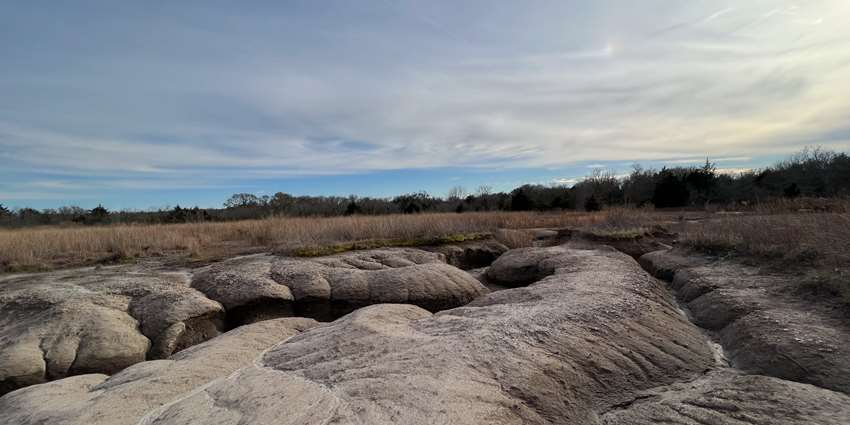Article originally written by Madison Pigg
Heavy erosion from the disturbed areas, where runoff flows into White Creek. (Photo courtesy of Stephanie deVilleneuve.)
Soil erosion caused by the movement of water along the topsoil of agricultural land is a silent cause of long-term ecosystem problems. On top of that, scientists have found that erosion is escalating due to the increase in rainfall intensity, caused by climate change.
New research co-authored by Stephanie deVilleneuve, a research specialist at the Texas Water Resources Institute, examined the impacts of soil mechanical disturbance and topsoil removal on soil erosion and deposition, soil moisture, soil-water infiltration, and vegetation type in a central Texas subtropical grassland setting. Recently published in Agrosystems, Geosciences & Environment, the study was co-authored by deVilleneuve, Austin Kelly, Noriki Miyanaka, Thiruvikram Shanmuhasundaram, Parker Murphree and Briana Wyatt.
Soil erosion is a contributing factor in deteriorating water quality, due to sediments ending up in nearby bodies of water, causing a threat to those who utilize that water for their needs, deVilleneuve said. It is estimated that 43.4 million km2 of land has been affected by this globally.
“We conducted the study over an area behind the College Station airport, where they disturbed a bunch of soil in the 1960s,” deVilleneuve said. “We wanted to look at it because it had an undisturbed area where they hadn’t done any work above it on this cliffside. So, we wanted to see, okay how does this disturbance of the soil impact infiltration or erosion? What are the impacts on the creek near the disturbed area of vegetation?”
The researchers noted that the amount of erosion was directly related to the removal of the topsoil, or in other words, when the topsoil was tilled or shifted due to human interference or natural interference. The soil composition changed from clay to sand, which is more likely to erode and dissipate due to its lighter composition.
The study was originally conducted by graduate students for a research project in a master’s level course. deVilleneuve is now pursuing her doctorate in Texas A&M University’s Department of Soil and Crop Sciences.
She said that the collaborative project idea was sparked because they wanted to find out the exact soil composition of the area, whether it was actually now clay or sand in the disturbed portion of the land. They did this by using MiniDisk infiltrometers, a HydroSense to determine the soil moisture content, and by taking soil cores. These samples were then taken to the lab and studied over the course of a month by the group.
The results showed proof that the shifting of the topsoil in this area had made the land nearly barren due to the soil composition it now has. When asked if soil erosion like this was inherently bad, deVilleneuve said, “It is not necessarily, it just means there is really not going to be a lot that you can do with that soil vegetatively.”
The invasion of non-native vegetation is also common for places in which the topsoil has been disturbed, she said. The non-native species overtake the nutrients and water supply, pushing out native grasses and plants. The infestation of non-native vegetation also affects area wildlife, as many of their food sources are depleted.
Analyzing the effects of soil disturbance on the nearby creek’s water quality was also important to the researchers. Their results showed that the creek had higher rates of sediment deposits, which can negatively impact both aquatic and terrestrial wildlife, she said.
deVilleneuve said that individuals can reduce their topsoil disturbance, therefore limiting erosion and protecting land. She recommended replanting native plants, possibly bringing in more soil to level the ground, and not disturbing soil close to natural water sources as beneficial ways to reduce impacts on the land.

For agricultural producers, deVilleneuve recommended using conservation ag strategies. “No-till, reduced-till, and even cover cropping are all really big things to help reduce erosion,” she said.
deVilleneuve’s research was featured on the cover of Agrosystems, Geosciences & Environment, Vol. 6, Issue 4, December 2023.



